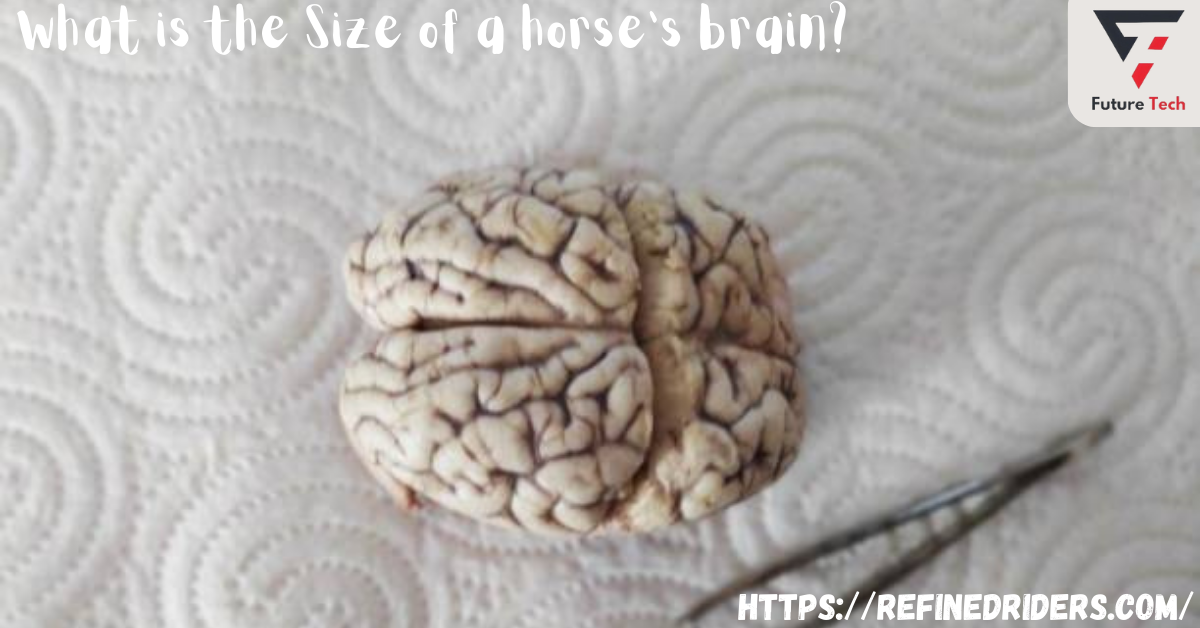For millennia, horses have enthralled people with their grace, power, and capacity to create strong emotional connections with people. Horses fluctuate slightly in size from one another and between breeds. Still, a horse’s brain is more significant than many other animals, making it an essential organ for survival and social interaction.
In this investigation, we get into the fascinating workings of a horse’s brain, its importance in training and behavior, and horses’ special cognitive skills. The size and makeup of a horse’s brain can bring you important insights into their world and the fantastic relationship between humans and horses, regardless of your level of experience with riding or your general curiosity about these amazing animals.
How Big Is the Brain of a Horse?
Horses are unquestionably gorgeous animals, which is one of the reasons some people find them attractive. The way a horse moves makes an impression, even from a distance. Horse ownership is comparable to owning other pets in certain aspects, such as the need for love and care.
However, a horse behaves differently than other animals, which makes it different. Horses are incredibly volatile creatures with unique personalities that make no two identical.
Horses are like people; you get pushy, quiet, wild, and calm. You and a horse can have a lifetime relationship with the correct pick.
The only kind of pet you can ride is a horse. Riding a horse is one option for outdoor enthusiasts to exercise while taking in the scenery. You can work out while exploring nature with a worthy friend, which is not the case at the gym.
Being aware of your horse’s mind
People sometimes question, “How big is a horse’s brain?” given the intellect and pride with which they carry themselves. It makes sense to be curious about how their brains develop and work. There exist ideas regarding the impact of equine brain weight on intellect. Understanding the structure of the horse’s brain can improve your comprehension of horses.
According to the Equine Behavioral Health Resource Center (EBHRC), a horse’s brain is around the size of a grapefruit or comparable to that of a young child. It weighs around 1/650th of its body weight, or 1½ to 2 pounds. Even though the human brain is more significant than other brains, several of its activities are comparable.
Human brains have a greater capacity for thought because of the influence of the brain-to-body mass ratio on cognitive abilities. The focus of the horse’s brain is different; it is more concerned with balance, fine motor abilities, muscle coordination, and bodily functions.
Equine Intelligence
Scientific research refutes the false belief that horses are capable of conditioned reflexes, demonstrating that the animals possess some cognitive ability. Horses in the wild must contend with the unpredictable nature of various predators. An animal raised for domestication must learn to coexist with humans in an artificial setting and assimilate their roles as caregivers, instructors, and parents.
Their highly developed senses enable them to navigate their surroundings. Horses rely on their “feelings” and sensations since they lack the same aptitude for deductive reasoning as humans. They, therefore, pick up knowledge by connecting gestures and cues to certain acts and behaviors. An animal that has come to associate certain sounds with hay, such as the squeaking of wagon wheels, understands when it is time for food. This pet’s repetition forms these associations. It is the reason why trainers constantly model appropriate behavior in the animal through body language.
The Size of a Horse’s Brain Image
It is insufficient to be aware of the size of a horse’s brain; one must also comprehend how it affects the animal’s behavior. Horses are difficult to handle, but you may modify your methods if you know how they think.
Because the two creatures do not behave similarly, human-centric viewpoints may pose problems when training your horse. You can better comprehend equine behavior by understanding concepts like right-brained behavior, which is the primary use of survival
side of the brain, and left-brained behavior, which uses the brain’s emotional side.
You realize that your horse is the center of your universe. As its parent, you can enjoy yourself if you know your horse well. You may purchase clothes or gifts from the horse collection section to add sass and style to your horse parenting.
Quantifying the Brain and Body Mass of Horses
In zoology, brain mass relative to body mass or weight is the starting point rather than brain size. Even in that case, weighing the body and the brain is not the solution. The most precise measurement method considers several physiological and anatomical elements, including the amount of water in the brain. The end product is a single number known as the encephalization quotient (EQ). After calculating the EQ for numerous animals, researchers arrive at the value for a given species. The parietal bones make up the skull’s domed “cranial vault.”
How Does the Equine Brain See This, Then?
Most EQ studies have been in zoological neuroanatomy; hence, only some equine researchers have studied them. The mature mixed-breed horses (no ponies) in this study by Cozzi et al. (2014) had their brains removed and weighed. First, scientists discovered that an adult horse’s brain weighs
Between 600 and 700 g. Horses two years of age and older had an average brain weight of 606 g and an average body weight of 535.22 kg. It indicated that the EQ of the study’s horses was 0.78.
The EQs for a few of the larger mammals are as follows: Human: 6.62, African Elephant: 1.67, Gorilla: 1.76, Cow: 0.55, Pig: 0.6, Camel: 0.61, Horse: 0.78, Goat: 0.8, Wolf: 0.9, Domestic Cat: 1.00. Here’s the calculation from the equestrian paper if it piques your curiosity. There is no set method; different scientists arrive at different conclusions.
P2/3Ea/Ee = 0.12 P2 / E i
Then, do horses have intelligence or not?
Improving cognitive ability is not always a direct result of greater brain mass relative to body mass. Thus, brain size serves as a rather broad indicator of intelligence. The brain’s exact regions and relative sizes are what count.
The larger the prefrontal cortex and frontal lobes, the greater the species’ capacity for “goal-directed” actions or the ability to evaluate information and respond appropriately [2]. The horse is more prone to react on the spur of the moment because of its comparatively small frontal lobes. It’s not that horses aren’t intelligent; it’s just that their ways of thinking and reacting are different.
The cracks in the brain are also significant. These are the furrows and furrows, called gyri (protruding outward) and sulci (sunken inwards). Although the surfaces of certain species’ brains are more sophisticated than those of others, they are universal to all species. If rat owners disagree, they will argue that rats are less intelligent than horses despite having smoother brain surfaces. Conversely, compared to primates, horses’ brains have fewer cracks.
The “cranial vault” is the space inside the skull. As the animal develops, exterior and inner surfaces precisely match the brain’s as it grows. A flawless mold of the cracks would be visible if you could peer into this skull area.
Indeed, Breeds Differ from One Another.
There is no doubt that the head forms of different horse breeds vary. These variations are marginal. Comparatively speaking, the proportions of the “neurocranium,” or the region above the frontonasal suture that includes the skull, were similar across breeds in a study involving TBs, STBs, and Arabians. The most variable area of the head, which gave the species their distinct appearances, was the lower jaw, specifically the maxilla and nasal bones [3]. There was no measurement of the skull itself in the study.
Conclusion:
In conclusion, the size of a horse’s brain is a fascinating aspect of these majestic creatures that have intrigued humans for millennia. With their grace, power, and unique ability to form deep emotional connections with humans, horses have always held a special place in our hearts. While horse sizes may vary slightly between individuals and breeds, their brains are relatively large compared to many other animals. Understanding the size and structure of a horse’s brain provides valuable insights into their behavior, cognitive abilities, and interactions with humans.
Despite misconceptions, scientific research has shown that horses possess cognitive abilities beyond conditioned reflexes. Their highly developed senses and ability to navigate their surroundings are essential for survival in both the wild and domesticated settings. By recognizing the differences in equine brain structure and function, we can better understand and appreciate these remarkable animals, fostering a deeper connection and more effective training methods. The study of a horse’s brain reminds us of the intricate beauty of nature and the complex relationship between humans and these extraordinary animals.




